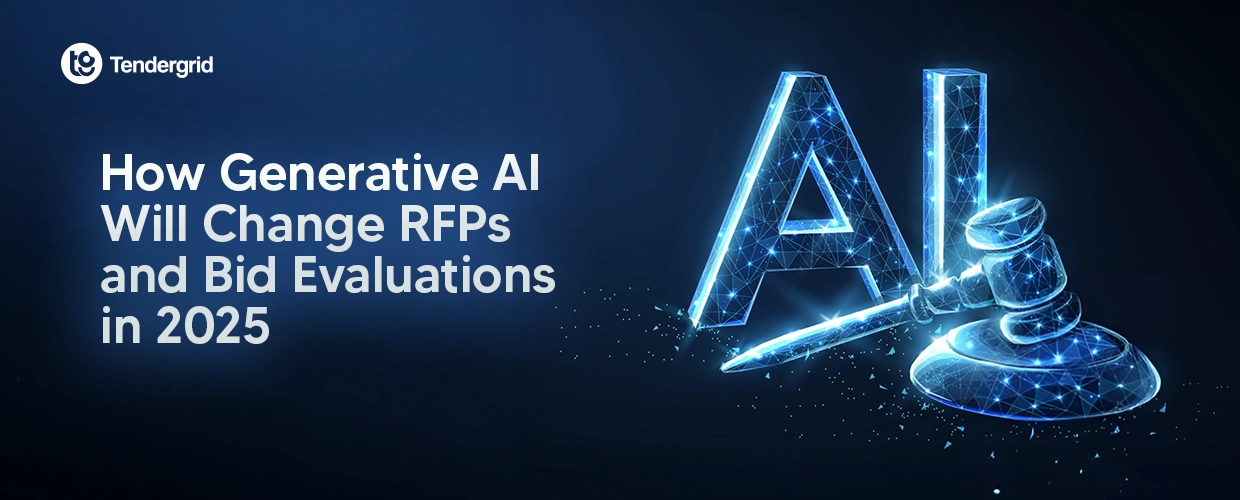If you’ve ever written an RFP or tried to respond to one, you already know the process is full of friction. There are too many online tender documents, too much repetition and not enough clarity. Whether you're on the buying side or the bidding side, government tenders can feel like a slow-moving machine. This is why generative AI is now matter's the most.
However, this is not going to magically fix everything overnight. But in 2025, it starts reshaping how tenders are created, submitted, and evaluated. And for people using Tender Grid platform to track and chase tenders every day, that shift is worth paying attention to.
Let’s break it down how that shift will actually play out.
Why the RFP Process Needs an Overhaul
If you’re managing government tenders or submitting bids, you’ve already felt the pain. Every RFP seems to come with a unique format, vague technical language, and lots of attachments. You end up creating responses under pressure, recycling content that “worked last time,” and spending days formatting tables that no one asked for.
Procurement teams don’t have it easier. They often get flooded with bloated, jargon-heavy responses that check the right boxes but don't offer clear value. This is why sorting, scoring, and aligning proposals with internal needs takes weeks and sometimes months.
Everyone’s chasing compliance and structure, but too much time is lost in paperwork, and not enough is spent on strategy.
Generative AI: Know what it actually does and what it doesn't!
Generative AI isn't just a writing tool. It’s a pattern recognizer. It has ability to learn from existing documents, guidelines, evaluations, and responses. In this way, it can draft proposals, summarize online tender documents, suggest pricing structures, and even flag potential risks.
But what AI doesn’t do: It doesn’t understand your business the way you do. It won’t magically help you to win government tenders. It won’t replace decision-makers. What it does is that it makes everything faster, more accurate, and less painful.
So, what does that look like in action? Read the section below for better clarity.
How AI Is Transforming RFP Creation
1. AI-assisted RFP creation
Let’s assume a government organisation needs to release a tender for a digital infrastructure upgradation. So, with the help of AI tools, the team doesn’t need to start from scratch. They can directly add project goals, constraints, and past RFPs document into the system, which generates a structured draft that can be modified later.
AI has speed but it also helps eliminate ambiguity in requirements, ensures consistency across sections, and even auto-inserts compliance clauses based on procurement rules.
2. Smarter vendor responses
For companies bidding on government tenders, AI acts like a bid assistant. It extracts content from previous submissions and tailor answers based on the scope. Also, it suggests ways to structure pricing, timelines, and team credentials.
It won’t write the entire proposal for you, and that’s a good thing. But it will reduce 50% of the heavy lifting so your team can focus on what matters: showing value.
3. Bid evaluation gets faster and more transparent
On the evaluator side, AI can speed up the shortlisting process. Think instant eligibility screening, side-by-side comparison of financials, and natural language summaries of 50-page technical sections.
The procurement heads can use AI tools to generate summary reports for review committees or to flag inconsistent pricing, missing documents, or vague milestones.
The result? Faster decisions, fewer manual errors, and better documentation if things are challenged later.
What should they do now as a Business or a Buyer?
If you’re a bidder, here’s how to stay ahead:
- Audit your past bids. See which sections are repetitive and start training internal AI tools using those.
- Build a content bank. All the case studies, testimonials, team bios, and certifications need to be centralized at one location so AI can use them effectively.
- Don’t copy-paste AI output. Use it as a starting point. Add your insights. Review carefully.
- Understand the evaluation metrics. AI help you align with the scoring systems if you give the correct and adequate data.
If you’re a buyer, then:
- Create AI-ready templates. Always ensure your inputs are structured properly which includes scopes, KPIs, and evaluation criteria.
- Train Artificial Intelligence with past RFPs and award data. This helps it get more smarter and improved time to time.
- Stay in control. Take assistance from AI tools by dictating it to get the final evaluation.
Risks and Limitations to Keep in Mind
Now let’s be clear. This isn’t magic.
Bad inputs = bad output. If your data is messy, your RFPs or responses will be too. There’s also the risk of vendors submitting overly polished but hollow proposals because AI made it sound smart without actually being strategic.
Plus, there's the bias issue. If AI is trained on poorly written or biased documents, it might perpetuate the same mistakes.
Bottom line? AI is a tool, not a brain. People still need to think.
What to Expect from AI in Tendering by the End of 2025
This year, we’ll see some big moves:
- Bid platforms with built-in copilots that help vendors pre-qualify and draft faster
- Government portals testing AI-assisted RFP creation using historical tender data
- More businesses are prioritizing data hygiene so they can make AI work smarter for them
- Hybrid teams where procurement specialists work alongside AI assistants in real time
By the end of the year, it’ll be less about “if” and more about “how well” you’re using AI in your tendering strategy.
Final Thoughts: Using AI to Work Smarter, Not Lazier
You don’t need to understand how generative AI models are trained. You don’t need to know what a transformer is. But you do need to understand what this shift means for your business.
The RFP and bidding world is about to get faster, fairer, and smarter. Not perfect. But a big step up from where we are now.
So whether you’re running a procurement cell or chasing your next big government tenders, get curious. Test the tools. Explore platforms that integrate AI into tender discovery, document drafting, and evaluation workflows.
Because the future isn’t about who can write the longest proposal. It’s about who can think clearly, move quickly, and let tech do the boring stuff.
For more such trending and informational blogs, Tender Grid will keep you posted. Thus, stay tuned to our page.

